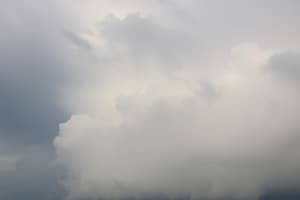Podcast
Questions and Answers
Match the following cloud types with their descriptions:
Match the following cloud types with their descriptions:
Altocumulus Clouds = Have flat bases and rounded tops, can bring light showers later in the day Altostratus Clouds = Gray and uniform, cover wide sections of the sky, often precede heavy rainstorms Nimbocirrus Clouds = Feature a cirrus appearance, extend below freezing level, associated with convective activity Stratus Fog = Obscures ground due to fog, thicker than mist, reduces visibility to less than one mile
Match the following cloud types with their characteristics:
Match the following cloud types with their characteristics:
Cumulonimbus Clouds = Towering, anvil-shaped clouds, reach heights of 40,000 feet or more, associated with severe thunderstorms and heavy precipitation Stratocumulus Clouds = Composed of low stratus clouds with a lumpy, undulating base, associated with fair weather Cumulus Conglomeratus Clouds = Formed when cumulus clouds merge into a larger mass, can bring heavy rainfall and lightning Cirrus Floccus Clouds = Similar to cirrus clouds but more lofty and wispy, form at high altitudes, often indicate fair weather
Match the following cloud types with their altitude range:
Match the following cloud types with their altitude range:
Low-Level Clouds = Below 6,500 feet altitude, mostly composed of water droplets Vertical Development Clouds = Characterized by growing vertically in a cumulonimbus cloud Special Forms of Clouds = Do not fit into standard categories listed above Lenticular Clouds = Lens-shaped clouds that form near mountains or hills, often stationary and do not produce precipitation
Match the following cloud types with their descriptions:
Match the following cloud types with their descriptions:
Match the following cloud altitudes with their corresponding cloud levels:
Match the following cloud altitudes with their corresponding cloud levels:
Match the following cloud types with their primary composition:
Match the following cloud types with their primary composition:
Match the following cloud types with their general weather associations:
Match the following cloud types with their general weather associations:
Match the following cloud types with their characteristics:
Match the following cloud types with their characteristics:
Match the following cloud types with their formation levels:
Match the following cloud types with their formation levels:
Flashcards are hidden until you start studying
Study Notes
Types of Clouds
Clouds are formed by water droplets suspended in the atmosphere, usually from the evaporation of sea or lake water. They play a crucial role in weather patterns, regulating temperature and precipitation. According to NASA, there are ten main types of clouds, classified based on their shape, altitude, and formation process. These cloud types can be further divided into high-level, mid-level, low-level, vertical development, and special forms.
High Level Clouds
High level clouds are found above 6,500 feet altitude. They are typically composed of ice particles. There are four types of high level clouds:
Cirrus Clouds
Cirrus clouds are thin, wispy clouds made up of ice crystals. They form at high altitudes and often indicate fair weather, although they may also signal that a storm is approaching.
Stratus Clouds
Stratus clouds have flat bases and cover large areas of sky, like a blanket. They form at higher levels and are associated with overcast conditions and drizzle.
Cumulus Clouds
Cumulus clouds are white, fluffy clouds with flat bases and rounded tops. They form at medium levels and are generally associated with sunny skies, although they can grow tall enough to release rain when they do so quickly.
Nimbostratus Clouds
Nimbostratus clouds appear dark and lowering. They form at mid to low levels and are characterized by continuous rainfall.
Mid-Level Clouds
Mid-level clouds are found between 6,500 and 20,000 feet altitude. They are primarily composed of liquid water drops. There are three types of mid-level clouds:
Altocumulus Clouds
Altocumulus clouds have flat bases and rounded tops and are most common during warm summer days. They can bring light showers later in the day.
Altostratus Clouds
Altostratus clouds are gray and uniform, covering wide sections of the sky. They form at mid to high altitudes and often precede heavy rainstorms.
Nimbocirrus Clouds
Nimbocirrus clouds feature a cirrus appearance but extend below the freezing level. They are associated with convective activity, such as thunderstorms.
Low-Level Clouds
Low-level clouds are found below 6,500 feet altitude. They are mostly composed of water droplets and sometimes fog. Some examples include:
Stratus Fog
Stratus fog occurs where the ground is obscured due to fog. It is thicker than mist and reduces visibility to less than one mile.
Cumulonimbus Clouds
Cumulonimbus clouds are towering, anvil-shaped clouds that can reach heights of 40,000 feet or more. They are associated with severe thunderstorms and heavy precipitation.
Stratocumulus Clouds
Stratocumulus clouds are composed of low stratus clouds with a lumpy, undulating base. They are associated with fair weather and can occasionally produce localized squalls.
Vertical Development Clouds
Vertical development clouds are characterized by their height, growing vertically in a cumulonimbus cloud. There are two types:
Cumulus Conglomeratus Clouds
Cumulus conglomeratus clouds are formed when cumulus clouds merge and form a larger, towering mass. They can bring heavy rainfall and lightning.
Cumulonimbus Clouds
Cumulonimbus clouds are towering, anvil-shaped clouds associated with severe thunderstorms and heavy precipitation.
Special Forms of Clouds
Special forms of clouds are those that do not easily fit into the categories listed above. Some examples include:
Cirrus Floccus Clouds
Cirrus floccus clouds are similar to cirrus clouds but have a more lofty and wispy appearance. They form at high altitudes and often indicate fair weather.
Mammatus Clouds
Mammatus clouds are a type of cloud with a distinct, pouch-like appearance. They are often associated with severe thunderstorms and heavy precipitation.
Lenticular Clouds
Lenticular clouds are lens-shaped clouds that form near mountains or hills. They are often stationary and do not produce precipitation.
In conclusion, the varieties of clouds are as diverse as the weather they bring. Understanding these different types can help us better predict and prepare for the weather conditions that follow.
Studying That Suits You
Use AI to generate personalized quizzes and flashcards to suit your learning preferences.




